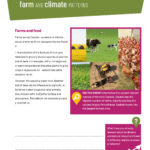How many plant hardiness zones are there in Canada?

 Explore climate regions farms found in climate regions across Alberta and find examples of the influences that climatic factors have on farming, including temperature, precipitation, growing season, growing zones and microclimates in FARM AND CLIMATE PATTERNS.
Explore climate regions farms found in climate regions across Alberta and find examples of the influences that climatic factors have on farming, including temperature, precipitation, growing season, growing zones and microclimates in FARM AND CLIMATE PATTERNS.
In FINDING PATTERNS, farms around your communities and graph average temperature and precipitation patterns in Alberta. Conduct a schoolyard investigation into microclimates and assess how these can apply to agriculture.
farm patterns
Farming requires farmers to see and understand the relationship between what they do and its connection to the land, soil, water, air and the natural plants and animals that live in their environments. Farmers consider themselves to be the caretakers of these environments. They also have to consider the climate of the area in which they farm and the weather patterns that affect their decisions on a daily basis.
Farmers use science, research, technology and education to continually improve their farming practices. This includes practices that adapt to climate and weather patterns.
a lentil story
Lentils are a type of pulse. Pulses include chickpeas, dry beans, dry peas and faba beans.
Lentils are actually the oldest known pulse crop. Canada only began growing lentils in the 1960s, but is now largest producer of lentils in the world.
Ninety per cent of Canadian lentil are grown in Saskatchewan, which has the climate and soil conditions needed to grow this plant.
Southern Alberta, central Alberta and the Peace River region have similar conditions and soil characteristics. More farmers in Alberta are now growing lentil crops.
Lentil crops need well drained soils and areas. They do not like fields that hold a lot of water. They prefer dry to moderately dry climates. They do best on level or slightly rolling land. Lentils are a cool season crop. Once temperatures reach 27°C or higher, too much heat reduces the rate of the growth of the plant.
![]() In what ways do you think soil conditions are connected to the climate of an area?
In what ways do you think soil conditions are connected to the climate of an area?
![]() Why do you think lentils are grown mostly in southern Alberta?
Why do you think lentils are grown mostly in southern Alberta?
cow comfort
Pleasant Hill Farms, a dairy farm run by the Pierik family is located in central Alberta. This dairy farm has about 400 milking cows.
Alberta winter brings its own set of challenges, and dairy farmers will go the extra mile to make sure the cows are comfortable and happy. This means enhanced daily routines, including extra “bedding” (straw) for them to lay in, and checking the water troughs hourly to make sure they don’t freeze. Farmers’ equipment can have trouble starting in freezing temperatures, just like your car at home.
hen houses
Canadian egg farmers use a variety of different systems to house their hens. What do each of these housing systems mean?
Conventional housing provides hens with small group settings that enable all birds to have equal access to fresh food and water.
Furnished or enriched housing is equipped with perches and a curtained off area to give hens privacy when laying their eggs.
Free run housing provides hens’ access to the entire barn floor area where hens can perch, scratch, forage and lay their eggs in nesting areas.
Free range housing provides hens with access to the outdoors, as weather permits.
Each system provides a clean environment, access to fresh food and water and protection from natural predators.
Since the Canadian climate can vary greatly, most hens are housed in barns that control the temperature. This allows farmers to keep the temperature in the barn consistent. Barns protect the hens from inclement weather like rain, snow, heat and humidity.
![]() How do egg farmers adapt to different climates?
How do egg farmers adapt to different climates?
![]() Do you think that egg farms can be found in any type of climate? Why do you think this?
Do you think that egg farms can be found in any type of climate? Why do you think this?
Story adapted from Egg Farmers of Canada: The Journey of the Egg.
chicken barns
Byron Ference, owner of Foothills Poultry, is a third-generation poultry producer just outside of Black Diamond in the Alberta Foothills.
With Alberta’s long winters, the success of a poultry farm depends a lot on their ventilation systems. At Foothills Poultry, their new barn features a neutral-pressure system. Chimneys on the roof suck the air out. Fresh air intakes pump new air in.
When the weather turns very cold, the balance of fresh air with the air in the barn has to be carefully monitored.
The birds’ behaviours can tell a lot about how comfortable they are. For example, if the birds are crowding near the walls, that can usually indicate that they might be too warm. If the birds are huddled in groups in the middle of the barn, then they may be too cold. Humidity is also important to monitor.
DID YOU KNOW that as chickens mature, they start to produce more of their own humidity. The fresh air brought into the barn is adjusted to account for this.





